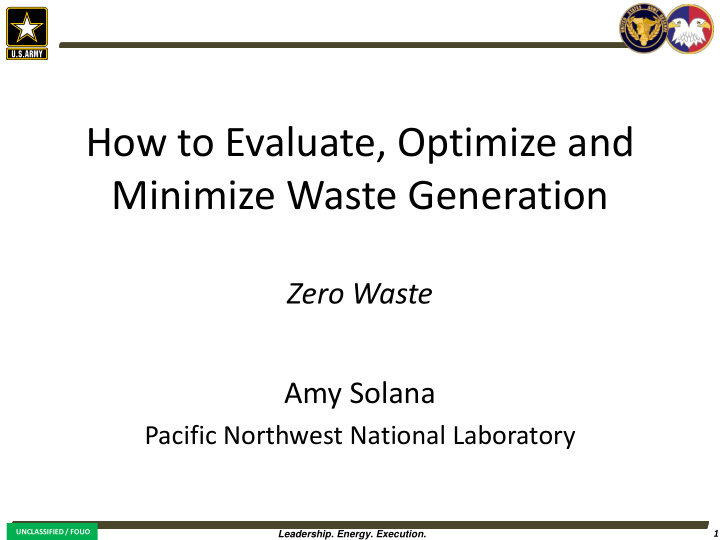



How to Evaluate, Optimize and Minimize Waste Generation Zero Waste Amy Solana Pacific Northwest National Laboratory UNCLASSIFIED / FOUO 1 Leadership. Energy. Execution. 04 OCT 2017
What is Net Zero Waste? • Reduce, reuse, and recover solid waste streams, converting them to valuable resources, with zero landfill over the course of a year. – Biosolids are included. – Hazardous waste is excluded. – Waste can be “recovered” in a waste -to-energy (WTE) facility, but byproducts (including ash) must ATTEMPT to be recycled. UNCLASSIFIED / FOUO 2 Leadership. Energy. Execution. 04 OCT 2017
Net Zero for Army Reserve 2012: Army Net Zero Initiative 2013: Army Reserve Center Pilot Program NZ energy, water, and/or waste at Army installations, 2014: Army Net Zero Policy NZ energy, water, AND waste including at each site - Fort Hunter Liggett (energy, Requires implementation of 10 Reserve Centers waste) cost-effective NZ energy, representing all regions and water, and waste measures - Parks Reserve Forces facility types Training Area (energy) All permanent CONUS and OCONUS sites maintained or - Fort Buchanan (water) operated with Federal funds Army Reserve NZ objectives are in alignment with policy guidelines UNCLASSIFIED / FOUO 3 Leadership. Energy. Execution. 04 OCT 2017
Pilot Program Results Summary • 83% average waste reduction/diversion potential from recommended measures UNCLASSIFIED / FOUO 4 Leadership. Energy. Execution. 04 OCT 2017
Net Zero Waste Results by Site UNCLASSIFIED / FOUO 5 Leadership. Energy. Execution. 04 OCT 2017
WTE and Reserve Center Locations UNCLASSIFIED / FOUO 6 Leadership. Energy. Execution. 04 OCT 2017
Common Waste Recommendations • Waste management program – Establish a waste lead and diversion plan – Communicate with and educate personnel – Establish on-site waste diversion infrastructure – Track progress • Source reduction – Electronic hand dryers in bathrooms (eliminate paper towels) – Reusable utensils and dishes (if practical to run dishwasher) • Diversion – Recycling – increase current recycling and partner with new companies for additional materials – Composting – small residential units typically sufficient • Waste-to-energy – Off-site, community WTE plants (insufficient waste for on-site plants) • Additional opportunities – Source assessment – what materials are used on-site and thrown away – Waste characterization – what types of waste and how much end up in the dumpsters – New diversion outlets – identify other companies for diversion opportunities UNCLASSIFIED / FOUO 7 Leadership. Energy. Execution. 04 OCT 2017
Success Story • Problem : American Samoa under boil water notice since 2010 due to E. coli detection • Solution : UV filtration unit purchased, to be used with water buffalos (reusable water containers for soldiers) • Savings : ~1,200 cases of bottled water annually (~$17,000/yr) UNCLASSIFIED / FOUO 8 Leadership. Energy. Execution. 04 OCT 2017
Pilot Program Outcome • More data is needed! – Developed recycling surveys • Data from recycling profile surveys is helping – Refine net zero assessment results – Direct next steps in purchasing needed equipment • Recycling equipment for 88 th RSC and 9 th MSC – Funding being pursued – Priority for NZ sites UNCLASSIFIED / FOUO 9 Leadership. Energy. Execution. 04 OCT 2017
What Can You Do? • Consider availability of on- and off-site waste diversion services – Equipment donation – Recycling – Composting – Waste-to-energy • Identify operational opportunities – Site personnel understand daily operations best – What can be changed (purchase less packaging)? – Behavioral changes are essential • Pursue projects (refer to assessments) • Obtain alternative sources/methods – Look for opportunities in local community • Volunteer organizations • Partnering to develop larger, economic projects • Identify additional sites to be evaluated for NZ waste potential UNCLASSIFIED / FOUO 10 Leadership. Energy. Execution. 04 OCT 2017
Net Zero Policy Implementation • Unfunded mandate – Use improved management practices – Use existing programs and resources and alternative financing • Develop life-cycle cost analyses to show cost-effectiveness – Utilize CEWWE results where available • Report accurately – SWARWeb used for ARIMD reporting requirements • Take advantage of training provided in existing Energy/Water/Waste Managers Workshops • Adapt net zero pilot best practices for site-specific use (Army and Army Reserve sites) – Shared on monthly calls UNCLASSIFIED / FOUO 11 Leadership. Energy. Execution. 04 OCT 2017
Amy Solana Net Zero Lead, ARIMD Pacific Northwest National Laboratory amy.solana@pnnl.gov (503) 417-7568 UNCLASSIFIED / FOUO 12 Leadership. Energy. Execution. 04 OCT 2017
BACKUP SLIDES UNCLASSIFIED / FOUO 13 Leadership. Energy. Execution. 04 OCT 2017
Official Army Net Zero Installation Policy Army Directive 2014-02 February 2014 • Requires implementation of cost-effective net zero energy, water, and waste measures – Army Reserve net zero objectives are in alignment with policy guidelines • Requires continual evaluation for new technologies / economics • Requires gaining local, regional, national support • Complements and exceeds existing reuse/reduction requirements • Includes all permanent, CONUS and OCONUS Army Reserve facilities operated/maintained by Federal funds UNCLASSIFIED / FOUO 14 Leadership. Energy. Execution. 04 OCT 2017
Recommend
More recommend